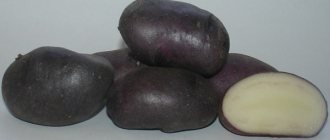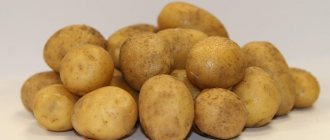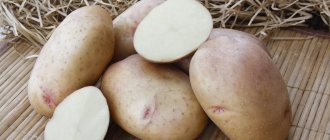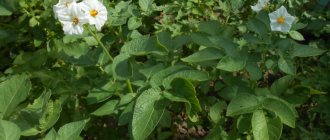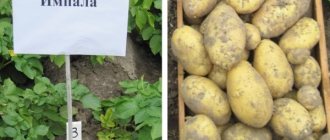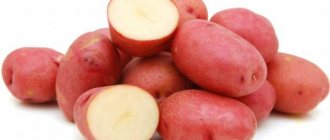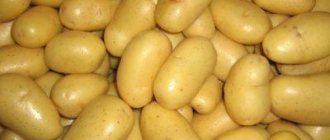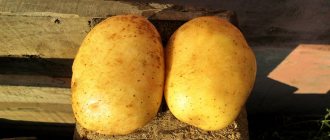Description of the potato variety Charodey
The Magician potato was bred by breeders of the Leningrad Scientific Research Institute of Agriculture "Belogorka", the Vavilov Institute of General Genetics and other organizations. An application for registration of a new variety was submitted in 1996, after which the potato passed successful tests and was included in the State Register in 2000. The crop is undemanding in terms of soil composition and agricultural technology, so it can be grown in many regions of the country:
- North and North-West;
- middle lane;
- Volgo-Vyatsky;
- North Caucasus;
- Volga region;
- Chernozem region;
- South of Russia;
- Far East.
In the State Register, the name of the variety is designated as “Sorcerer”, although in practice another name is allowed - “Sorceress”. Main characteristics of potatoes:
- mid-early – 80–90 days;
- table – starch content from 12.5 to 15.0%
- plant of intermediate type.
The bushes are erect, moderately spreading, with medium-sized light green leaves. The edges of the leaf plates are aligned, the waviness is weak. The corollas are small and completely white.
The Magician potato tubers are oval, leveled, slightly flattened. The surface is smooth, the eyes are small, barely noticeable. The peel is yellow. The sizes of the root vegetables are medium and large: weight 75–115 g, diameter 3–5 cm. The cut flesh is white, quite dense, and practically does not boil. The taste is good.
Attention! The marketable yield of Charodey potato tubers ranges from 84 to 97%, which corresponds to common standards.
The crop can be grown both for personal consumption and for sale.
Potatoes Magician are valued for their pleasant taste and high yield
Description
The Charodeyka potato variety was obtained in Russia. He was bred in St. Petersburg and entered into the State Register in 2000. The tests were carried out over four years, and they confirmed the unique characteristics of the potato.
Productivity
Potato Charodey is a mid-late variety and its ripening period is three months. From one hectare you can collect up to 350 centners of tubers. Productivity depends on proper care and nutrition of the soil.
Tubers have good taste
A special feature of the variety is that it has good resistance to nematodes and late blight.
Important! For prevention, potato sprouts are treated with insecticides.
The tubers are elongated, oval-shaped, yellowish. The peel is smooth with small superficial eyes, the flesh is white. The average weight of a potato is 80 g, but with good care it grows up to 100 g.
What regions is it suitable for?
The variety is adapted to different regions of Russia. It can grow in the southern regions, the Far East, and the north. The Enchantress potato is zoned for the Middle Volga, Volga-Vyatka, North Caucasus and other regions.
Taste qualities
The variety has a sweetish taste and is suitable for preparing various dishes. It can be stewed, baked, boiled, fried. Potatoes do not get overcooked and retain their shape. Does not darken after heat treatment.
Characteristics of the potato variety Charodey
The variety tolerates drought and heavy rainfall well, and is resistant to frost (if the bushes are well hilled). Keeping quality is quite high - 96%. The peel is durable, so the tubers can be transported over long distances. Area of application: frying, baking, boiling. It makes a very tasty and airy puree.
Productivity
The Magician potato ripens in 2.5–3 months from the moment the first shoots appear. The number of tubers on a bush reaches 12–15 pieces. Yield indicators:
- 0.9–1.8 kg from 1 bush;
- 2.7–3.5 kg per 1 m2;
- 270–350 kg per 1 hectare.
The maximum registered yield of the Charodey potato according to the State Register is 419 kg per hundred square meters. To obtain a stable number of tubers, potatoes should be grown in fertile and light soils, and normal care should be provided:
- water during drought;
- hill up 2-3 times per season;
- fertilize at least twice;
- mow the tops 14 days before harvest;
- change seed every three years.
Advantages and disadvantages
Potato Magician is a fairly common variety, known for its pleasant taste and good keeping quality. If conditions are met, it can be stored until late spring.
Rounded tubers of the Enchantress have an attractive presentation
pros
- pleasant taste;
- high, stable yield;
- unpretentiousness - can be grown in many regions;
- resistance to drought and frost;
- good keeping quality and transportability.
Minuses
- weak immunity to late blight;
- not resistant to potato nematode.
Characteristics of culture
The sorcerer potato is a very popular variety in the Russian Federation. Such popularity was acquired by its characteristics, in particular drought resistance and excellent taste.
The pulp of the root vegetable does not darken when peeled and cooked. It tends to crumble during heat treatment.
The tubers are not afraid of mechanical stress, so they are ideal for transportation and harvesting mechanically. Considering also the fact that the Magician is distinguished by high shelf life, we can conclude that the variety is excellent for commercial cultivation.
Characteristics of the variety:
- Mid-season table variety. Tubers ripen approximately 3 months after planting.
- The weight of root vegetables is from 70 to 120 g.
- The bushes are medium-sized, upright. The tops are very spreading. On average, one bush produces up to 15 large tubers.
- The leaves are large, light green in color. The Enchanter has leaves without wavy edges, which is not typical for potatoes.
- The corollas consist of large white flowers.
- The yield is average - approximately 300-350 c/ha.
- Keeping quality indicators reach 97%.
- The color of the Sorcerer's shell is yellow, the color of the flesh is cream.
- The variety is resistant to potato blight, but often suffers from potato nematode.
- The tubers have a sweetish taste and are ideal for making purees and soups.
Landing rules
Potatoes Magician are planted in an open, illuminated area without stagnant moisture (not in a lowland). Optimal soil: fertile and light (sandy or loamy). It is better to start preparing the field the day before in the fall, but if the deadline has passed, you can do it in April:
- First you need to clean and dig 30–40 cm deep.
- If the soil is depleted, add 5–7 kg of humus or compost or 30–50 g of complex fertilizer per 1 m2.
- If the soil is heavy (clayey), it is fertilized with sand or sawdust (500–800 g per 1 m2).
The Charodey potato tubers begin to be prepared for planting 3–4 weeks in advance. They are transferred to a lighted, cool room (temperature 14–16 °C) and laid out on the floor or in wooden boxes. Damaged tubers are discarded. The rest are periodically sprayed with water, and on the day of planting they are treated with potassium permanganate or fungicide: “Hom”, “Fitosporin”, Bordeaux mixture. You can also use drugs to accelerate growth - for example, Zircon or Epin.
Planting of the Charodey potato begins in the first ten days of May (in the North and North-West - in the middle of the month). At this point, the soil should have time to warm up to 8–10 °C. This can be determined with a thermometer by burying it in the hole for 15 minutes.
The algorithm for planting potatoes Magician is standard:
- Mark several furrows at a distance of 70–80 cm.
- Place the tubers to a depth of 5–10 cm.
- Leave a distance of 30–40 cm between adjacent holes.
- Dust with ash and bury.
On large areas, planting, hilling and harvesting Charodey potatoes is easier to do with a walk-behind tractor
Landing Features
Before you start planting potatoes, all seed material is sorted out. Rotten, damaged, small tubers are thrown away as they will not produce a good harvest. Large, strong, healthy potatoes are suitable for planting.
The selected material is placed in a dark place and lightly moistened with water. They should germinate within a month and after that they can be planted. Additionally, treatment with growth stimulants, for example, Mival, is allowed.
Due to the long ripening period, potatoes can be planted only after the soil has warmed to 8 °C. In the southern regions this is possible at the end of April, and in the rest - at the beginning of May.
It is best to grow the Enchantress variety on light soils - loamy, chernozem, sandy.
Important! It is undesirable to grow potatoes on clay soils, as this increases the risk of fungal diseases.
Planting process
For planting, a standard scheme is used. Holes 8 cm deep are dug for it. A distance of 35 cm is maintained between them. This arrangement allows the bushes to grow spaciously and they will not shade each other.
A distance of 60 cm is maintained between the rows. For a large field, it is better to increase this figure to 80 cm. You should not arrange the bushes in a crowd, as this will lead to a small harvest. There is no need to bury the tubers deeply; the optimal depth is 8-10 cm.
After planting, potatoes are watered generously. It is better to carry out work on a sunny day in the early morning or late evening.
Important! You cannot plant the Magician variety after tomatoes, potatoes, and eggplants. You can use the soil after such crops as cabbage, beets, cucumbers.
Features of cultivation
Standard care:
- After planting, the soil is loosened several times.
- Watering is carried out only during flowering and during drought: 1 10 liter bucket is licked for 3-4 bushes.
- The sorcerer potatoes are fed 3 times - during emergence, at the budding stage and during flowering. It is optimal to give complex fertilizer or a mixture of superphosphate and potassium salt.
- Hilling of the Magician potato is carried out at least 2 times: when the tops grow to 15 cm, then during flowering. The procedure can be repeated after another 2–3 weeks.
- Loosening is carried out regularly, especially after rains and watering, and weeding is carried out as necessary.
Features of caring for the variety
The sorcerer is one of those varieties that you can almost forget about after planting. Even if you don’t water, hill up or weed the potatoes, they will still grow, but high yields are definitely not achieved under such growing conditions. Caring for potatoes is not difficult and does not take much time. You need to pay attention to the crop several times throughout the entire season, and it will delight you with the yield of the harvest.
Watering potato bushes
Since the Magician tolerates even long dry periods well, it only needs special watering:
- during the appearance of buds;
- after flowering;
- when there is no rain for more than 2 weeks in a row.
For irrigation, take warm water, the consumption rate for 1 bush is 2-3 liters. Before watering, you need to make sure that the soil is completely dry. Loosen the soil to a layer of 6-7 cm; if it is dry, then moisten it. Over the entire season, the number of waterings should not exceed 4-5 times.
Attention! When watering with a hose, do not allow water to get on the flowers, as this may cause them to fall off.
Weeding and hilling of soil
Along with the appearance of young potato tops, weeds and small grass grow in the soil. It must be removed immediately as it appears, without waiting for it to grow. The shoots greatly interfere with the development of the crop, which means it delays fruiting for several weeks. In addition to increasing the period, it is often the weeds that are carriers of diseases and pests, so the risk of infection in tops and tubers increases. Weed the ground at least 1-2 times a month.
Another necessary procedure for potatoes is their hilling. It is carried out twice:
- with a tops height of 15 cm;
- before flowering begins.
They rake the soil from the rows onto the bushes to form a hill. The procedure should be carried out after rain or after watering, then it is more convenient to work with the soil.
Fertilizing potatoes
Farmers who grow Enchanter on an industrial scale use various fertilizers to increase the number of fruits on each bush. Feeding is carried out 3-4 times per season:
- after the tops appear;
- during the formation of buds;
- during flowering.
For the first feeding, nitrogen fertilizers are used: nitrophoska, ammonium nitrate. Dilute a tablespoon of any of these substances and irrigate the bushes. Another way is to feed with liquid mullein, diluted with water in a ratio of 1:10. The second feeding is carried out with ash (200 g) and potassium sulfate (15 g) per 10 liters of water. It is necessary for abundant flowering and improving the taste characteristics of the crop. The third time, phosphate fertilizers are added to the soil, for example, watered with superphosphate (1 tablespoon of substance per 10 liters of water). This stimulates the formation of root crops.
Treatment against diseases and pests
Even the presence of good immune abilities in the Sorcerer is not a reason to neglect spring treatment against diseases and pests. Healthy bushes can suddenly become ill: first the leaves, and then the tubers themselves. At least once or twice during the spring, antiviral prophylaxis is carried out using Bordeaux mixture, copper oxychloride, Fitosporin, Ridomil.
Of all the known pests, the danger for the Magician is the nematode - worms that damage tubers and tops. Infection can be prevented by keeping the area clean and carefully selecting only healthy tubers for planting. Garden tools are also treated before any land work with a weak solution of potassium permanganate, since even a shovel can carry larvae and other pathogenic flora.
On a note! You can defeat the Colorado potato beetle that has attacked potatoes using Sumi-Alpha, Karate, and Arrivo.
Pests and diseases
Potato Magician, according to the State Register, is immune to cancer and moderately resistant to blight. However, it is not resistant to potato nematode and other pests: aphids, Colorado potato beetles and May beetle larvae. Therefore, summer residents should take care of basic preventive measures:
- Correct crop rotation. The site should be changed every 3-4 years. You cannot plant in a field where any Solanaceae previously grew, including potatoes, tomatoes, sunflowers, and eggplants. The best predecessors for the Magician potato are legumes, cabbage, cucumbers, and root vegetables.
- Near the field you can plant fragrant tobacco, calendula, coriander, marigolds and other plants to repel insects.
- Be sure to pickle the tubers in potassium permanganate before planting.
- Carry out a single treatment with a fungicide to prevent fungal diseases (when the seedlings grow to 15–20 cm).
- Mulch the plantings with straw or sawdust, and use folk remedies to control insects.
To treat the Magician potatoes, proven fungicides are used:
- "Fitosporin";
- "Quadris";
- "Prestige";
- "Maksim";
- Bordeaux mixture.
To repel insects, the bushes are dusted with ash, a weak tar solution is poured into the rows, and sawdust is poured into the rows. You can also treat the plants with an infusion of garlic, chili pepper or mustard powder. It is also allowed to spray with insecticides 1–2 times:
- "Decis";
- "Spark";
- "Agravertine";
- "Aktellik";
- "Biotlin";
- "Colorado".
Chemical and folk remedies help to cope with Colorado potato beetles on the Magician potato
It is advisable to treat bushes in dry and windless weather, early in the morning or before sunset. If the bushes have suffered from late blight, it is better to immediately dig them up and burn them.
Attention! After harvesting the Sorcerer potato crop, you must immediately remove the tops, take them away and destroy them. This significantly reduces the risk of pests appearing next season.
Diseases and pests
Late blight
The immunity of this variety is also quite decent.
Provides the plant with protection against viruses A and Y, late blight and potato cancer. However, it provides little protection against golden nematode worms. correct crop rotation helps , in which it is recommended to include legumes and grains.
Of the chemical control agents, Nematorin copes better than others, which must be introduced into the soil before planting.
Harvesting and storage
The Charodeika potato harvest is harvested after 2.5–3 months, i.e. around the beginning or middle of August. To do this, it is better to choose a dry and warm day. If you mow the tops to 10 cm in 2 weeks, the tubers will have time to gain additional mass.
The collected root crops are placed on harrows to dry, then sorted and packed into bags. They are taken to a dark room and stored at a temperature of 12–15 °C for two weeks, and then at 2–5 °C and a relative humidity of 70–80%.
Advice! Small and damaged sorcerer potato tubers should be consumed first.
Planting and growing potatoes
Due to its absolute unpretentiousness, to obtain maximum yield, you need to follow only a small number of basic recommendations.
Optimal planting dates
It is generally accepted that the best period for planting potatoes is the first half of May, but this is not always true.
There are two factors that directly affect the growth and development of potatoes and, accordingly, the final yield:
- Soil temperature should be at least +8°C at a depth of 10–12 cm. At lower temperatures, potato tubers will germinate poorly and slowly.
- Soil moisture - not dried soil can lead to rotting processes and many fungal diseases, as a result of which you can lose the entire bush.
To correctly select the landing time, it is necessary to analyze in advance weather forecasts for the period of interest, preferably from several sources. There is also a popular belief that it is better to start planting potatoes during the period between the flowering of the bird cherry tree and the appearance of leaves on the birch tree.
Did you know? Belarusians are the leaders in potato consumption in the world. Each resident of this country eats at least 180 kg of potatoes per year.
Crop rotation rules
Many experienced gardeners are familiar with the basic rule of a good harvest: the need for crop rotation, that is, maintaining alternation of crops when planting. This means that it is not recommended to plant one crop in the same place every year.
The ideal place for planting potatoes is after growing cucumbers, beets, cabbage or green manure. Last year's beds that were used for tomatoes, peppers, eggplants or other varieties of potatoes are highly not recommended.
An alternative to the crop rotation method is the parallel cultivation of crops of different types in one area. As practice shows, many plants have the property not only of not competing, but also of providing mutual assistance.
So, for potatoes, compatible crops are:
- beans;
- onion;
- corn;
- garlic;
- mint;
- salad;
- radish;
- carrot.
Find out more about how to choose the best green manure for potatoes.
It is thanks to the proximity of these plants that potatoes become stronger and increase productivity, and also show resistance to various diseases.
Soil requirements
The sorcerer is not picky about the soil and can give good results with any composition. However, if possible, it is better to allocate a place for planting on sandy or loamy soils. Like almost all varieties, these potatoes will grow best in pre-fertilized areas of land.
Typically, one of the following fertilizing methods is used for such purposes:
- In the process of preparing a plot for potatoes in the autumn, 1 kg of saltpeter, 1.2 kg of potassium fertilizers and 0.7 kg of phosphates are applied per 1 hectare of land. Any organic fertilizers are also added. After this, the soil is dug up to a depth of about 20 cm.
- After harvesting, the area is sown with any green manure (for example, winter rye, fodder peas, white mustard, etc.). After green manure crops germinate and the plants reach about 25 cm in length, the greens are embedded into the soil using a shovel or hoe.
Did you know? Potatoes became the first vegetable grown in space.
Preparation of planting material
Before planting, potatoes are carefully sorted, leaving only large tubers weighing about 100 g and rejecting potatoes with various defects: traces of rot, cracks, etc.
Since this vegetable is stored in a cool place (cellar, basement), 30–40 days before planting, the tubers are transferred to a bright room with an air temperature of at least +15 ° C - during this time they acquire a green color, and solanine is produced in the pulp, which will protect the plant from pests at first.
For planting, select fruits whose sprouts do not exceed 15 cm. It is recommended to pre-treat the tubers with a growth stimulant, as well as a solution to combat Colorado potato beetles.
Read in more detail about how and how to properly process potatoes.
Landing technology
The prepared area must be marked into rows with a step of 70 cm and a distance between holes of 30 cm. The tubers are deepened into the ground up to 10 cm and covered with earth. It is recommended to first place a handful of onion peels and ash in each hole.
Total information
The patent for the variety belongs to the Belogorka Research Institute of Agriculture and the Institute of General Genetics named after. Vavilova. This species was added to the state register more than 15 years ago. Potato Magician, the description of which is presented in this article, is recommended for cultivation in the following regions:
- Central Black Earth Region;
- Far East;
- North Caucasus;
- Volgo-Vyatsky;
- Northwestern.
The variety is planted for sale and for oneself. It withstands temperature changes and does not cause major problems. Potatoes are well transported and do not lose their presentation. Soil with almost any composition is suitable for it.
The sorcerer is a mid-late variety, the tubers of which are ready for harvesting in 80-90 days. About 35 tons of crop are obtained from one hectare. Of these, 2-3 percent are obscene specimens. From 12 to 14 potatoes are harvested from one bush. The weight of one is from 80 to 130 grams. Some tubers reach 150 grams.
Ginkgo Biloba - uses and beneficial properties
Sorcerer's bushes are erect and spreading. Lush crowns provide shade, which helps retain moisture in the ground. The leaves do not have wavy edges and are light green in color. The inflorescences smell pleasant.
The potato pulp has a milky hue and a sweetish taste. Its color and shape remain unchanged when boiled or fried. This is due to the low starch content (12-15%).
Care
To obtain a high yield, the Magician variety is given good care. Before emergence, the soil is loosened so that the tubers receive more oxygen. Periodically weed the weeds.
When the shoots appear, you need to loosen the soil between the rows. Loosening after watering and rain is especially important, which avoids the formation of a crust.
The Magician variety is not watered until the buds appear. When flowering begins, the soil is constantly moistened. When the soil dries 7 cm, start watering.
Potato plantings are watered with warm water in the evening. Each bush requires 2-3 liters of water. During drought, the field is watered more often, up to 3-5 times during the season.
Hilling and feeding
An obligatory step in caring for Sorcerer potatoes is hilling. The procedure is carried out twice per season: when the bushes reach a height of 15 cm and before flowering begins. As a result, the formation of new root shoots is activated, the soil is saturated with oxygen and weeds are destroyed.
Hilling is carried out after watering or rain. The soil is raked from the rows onto the potato bushes. To do this, use pitchforks or special equipment.
Fertilizing potatoes with Magic helps to increase productivity:
- with active growth of tops;
- during the formation of buds;
- during the flowering period.
The first feeding is necessary for the Magician variety with slow development of bushes. Nutrients are needed by plants with thin stems and pale leaves.
For treatment, a solution is prepared based on slurry, which saturates the plants with nitrogen. It is also allowed to water the potatoes with a urea solution in the amount of 1 tsp. on a bucket of water.
The second treatment requires a solution consisting of 1 cup of wood ash and 1 tbsp. l. potassium sulfate. Fertilizer improves the taste of potatoes and promotes abundant flowering.
The third feeding of the Charodey variety is carried out using 1 tbsp. l. superphosphate per 10 liters of water. The treatment stimulates the formation of tubers. 0.5 liters of the resulting solution is poured under each bush.
Growing and care
Due to the fact that the crop can withstand any weather changes - from drought to prolonged rains, care is not particularly difficult.
It is important to loosen the soil in time and watch for weeds.
Also, potatoes can be planted in any type of soil , however, when growing on heavy clay soil or in swampy lowlands, it is recommended to make raised beds. In this way, it is possible to ensure faster ripening and active development of the crop. In addition, such a bed will always be maximally illuminated and heated by the sun's rays.
Planting methods
Potatoes are planted at intervals of about half a meter.
They are planted in two ways - manually and mechanized.
- If the manual method is used, use a shovel to dig a hole half a meter deep, while maintaining a distance of 50 centimeters and 70 centimeters .
- If machinery is used, a long ditch is dug, about half a meter .
- The distance between rows should be at least eighty centimeters.
Planting units are located at a distance of 20 centimeters from each other.
Land preparation
The soil for the garden bed is prepared in the fall. To do this, you need to clear the area of weeds, plant debris and other debris.
A bed prepared in the fall.
- Next, the site should be dug up, and fresh manure, compost, phosphorus and potassium fertilizers should be added. Leave it this way until spring.
- In the spring, the future potato bed is loosened again, weeds or other debris are removed.
- The seed material is taken out of the cellar approximately three weeks before planting and carefully inspected.
- If damaged or diseased root crops are found during inspection, they should be immediately destroyed.
- Then the selected planting material is placed in boxes or nets and left in a well-ventilated area, periodically spraying the potatoes with water.
- The temperature should not exceed fifteen degrees above zero.
Immediately after planting, you need to water the potatoes!
Immediately before planting, you need to inspect the tubers again. If potatoes with thin thread-like shoots are detected, this means that these units are infected with a potato virus; they must be destroyed and not used for planting.
